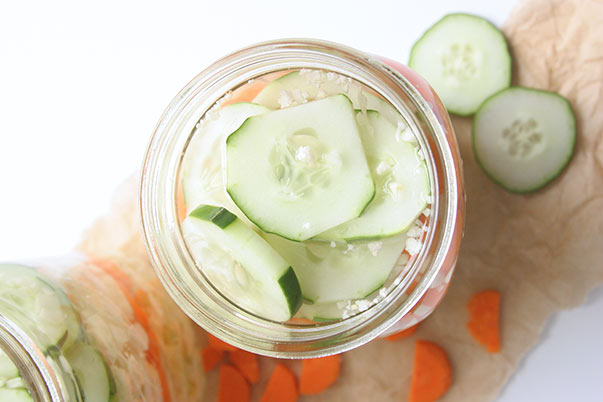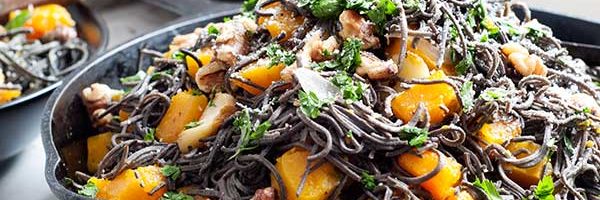
How to Make Gluten-Free Fermented Vegetables
Fermented foods – also called cultured foods – are rich in good bacteria. The microorganisms (probiotics) in fermented vegetables are incredibly beneficial for the health and integrity of the gut. Fermented vegetables support the immune system at a fraction of the cost of probiotic supplements. Especially for those with a history of food allergies or sensitivities, fermented vegetables are an excellent healing food to incorporate on a regular basis.
Fermentation can take many forms, but perhaps the simplest method is using a basic salt water brine to preserve the vegetables while still allowing for growth of beneficial organisms. Once fermentation is complete, the vegetables can be stored in the refrigerator for months.
Use your fermented vegetables to top omelets, cooked meats, burrito bowls, and tacos. They’re also delicious mixed into salads and slaws.
Fermented End-of-Summer Vegetables
(Gluten-free, Grain-free, Dairy-free, Egg-free, Nut-free, Soy-free, Refined Sugar-free, Vegetarian, Vegan)
As summer draws to a close, farmers’ markets overflow with a bountiful harvest of vegetables like cabbage, broccoli, cauliflower, carrots, cucumbers, and herbs. Fermenting these foods will both preserve them and transform them into probiotic gems bursting with nutrients.
Makes 2 (1-quart) jars
- 2 (1-quart) wide-mouth glass jars with plastic lids
- 2 tablespoons sea salt
- 4 cups filtered water
- Chopped carrots
- Chopped cauliflower, broccoli, or both
- Chopped green cabbage
- Sliced cucumbers
- Cabbage leaves (for the top)
Optional flavorings:
- Finely chopped garlic
- Chopped dill
- Chopped basil
Clean and dry your jars and lids. In a glass measuring cup, dissolve the sea salt in the water. Set aside.
Add your favorite combination of vegetables and flavorings (if using) to the jars. It doesn’t matter how you layer the ingredients. Just toss them in – it couldn’t be easier. Leave about an inch or so of room at the top of the jar.
 Stir the salt water mixture again. Then pour it over the vegetables in the jars, leaving ½-1 inch of space at the top. For each jar, fold a small cabbage leaf so that it fits snugly into the jar and press it into the salt water so that it is completely submerged and covers the vegetables. Screw the plastic lids on tightly to the jars. Place the jars in a container of some kind (I use a glass loaf pan) to catch any juices that may leak out during the fermentation process.
Stir the salt water mixture again. Then pour it over the vegetables in the jars, leaving ½-1 inch of space at the top. For each jar, fold a small cabbage leaf so that it fits snugly into the jar and press it into the salt water so that it is completely submerged and covers the vegetables. Screw the plastic lids on tightly to the jars. Place the jars in a container of some kind (I use a glass loaf pan) to catch any juices that may leak out during the fermentation process.
Place the jars in a location out of direct sunlight. After 2 days undisturbed, begin to open the jars once a day to release any gasses. Quickly screw the lids back on the jars. This is called “burping.” You’ll likely see some bubbling throughout the fermentation process and may even hear it. This is normal.
After 5-6 days, you can begin to taste the vegetables to see if you think they are tangy enough. I typically let my vegetables ferment for 7 days, but you can continue to ferment for 8, 9, or even 10 days until the desired flavor is reached. Once this happens, store your vegetables in the refrigerator where they will last for months … although I’ve never had a jar go longer than a month before I ate it all!
Tips & Tricks
- Use plastic lids for your jars instead of metal, as the acid and salt can corrode metal quickly.
- Do not open your jars to “burp” them more than once per day. Keeping them tightly sealed is important for the fermentation process.
- Keep fermenting foods out of direct sunlight.
- If you’re new to enjoying fermented foods, welcome! Introduce them gradually into your diet by consuming just 1-3 tablespoons per day in the beginning. This will give your digestive system a chance to become “friendly” with the new bacteria and reduce chance of an upset stomach.
- Every once in a while, though you may seem to do everything right, a batch of fermented vegetables just looks and tastes “off.” If your vegetables look or taste slimy or moldy, or if they have a very strong odor, discard them and start a new batch. (They should smell and taste “sour” and briny, but it should not be overpowering.)
Written by Hallie Klecker



